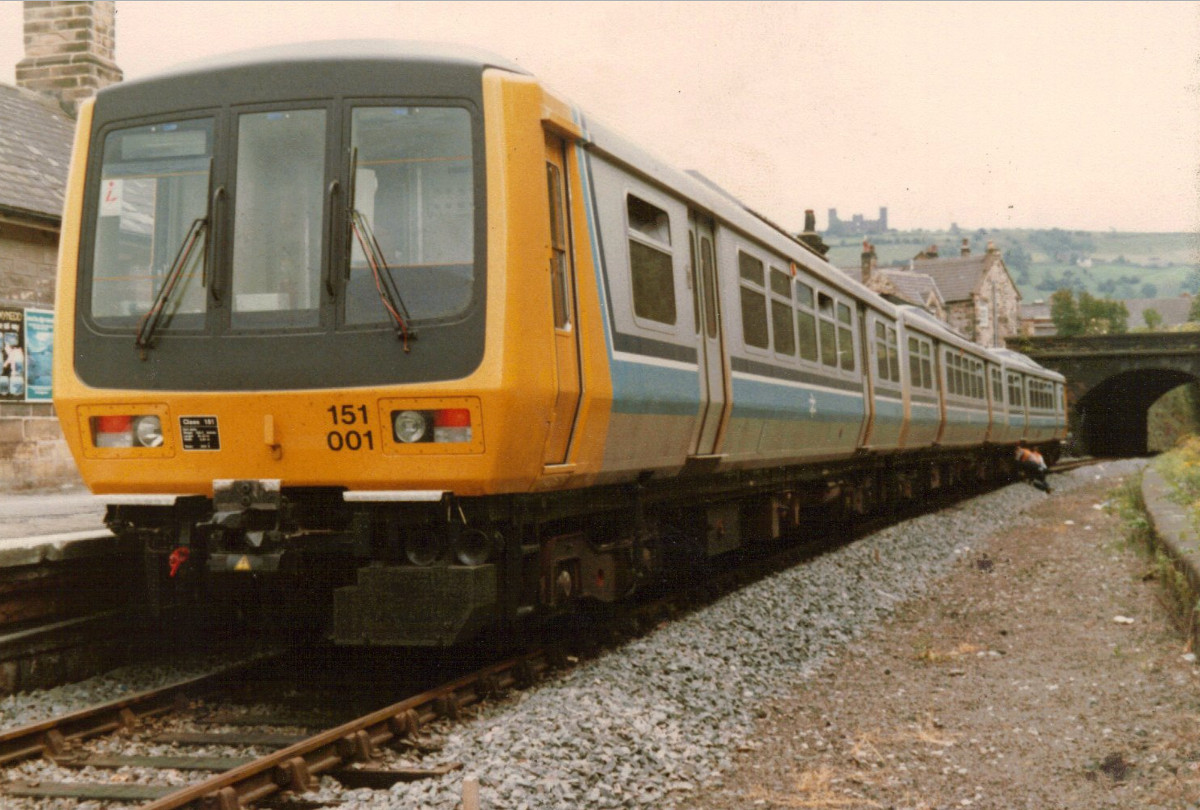| Re: OTD - 6th Feb (1986) - Class 151 enters public service Posted by paul7575 at 16:25, 7th February 2022 |     |
I’ve a funny feeling that the new AC motors on the SW 455s will be tailored to the specific bogies, and will still be fitted during their final move to the scrapyard. Might the relatively new traction electronic packages be recyclable onto another class though? I suppose the number of DC motored classes is quickly reducing to minimal numbers, unfortunately…
| Re: OTD - 6th Feb (1986) - Class 151 enters public service Posted by stuving at 12:52, 7th February 2022 |     |
Classes 319 and 365 have quite a lot in common. Both were designed for both AC and DC supplies, and have a 750 V DC bus feeding the motor drives. Both use GTO thyristors, which are halfway between plain thyristors and IGBTs in what they can do.
In 319s the thyristors replace the cam switches, resistors etc in controlling DC motors. The 365s were the first (I think) use of AC motors with a variable voltage/variable frequency drive. This is now the standard design, but using IGBTs. While 365s were built for DC as well as AC, this was hardly used and over the years bits have gone missing and become obsolete and unreplaceable. For a thorough rebuilt this isn't a big issue, though perhaps adds cost.
In choosing 319s for the 769 conversion, availability was one factor for Porterbrook. The 365s have the odd "feature" of being accidentally nationalised, though that ought not to matter in this (but I'm sure does). Also, there are only 40 of them, pushing up the fixed costs (design etc.) per each - which is academic, with hindsight.
But the real technical issues are only going to be known to those involved. It may well be that the motor drive in the 365s would not cope well with whatever the motor-generator sets put out. Or maybe the DC motor drive is seen as more robust.
And opinions vary as to the relative grottiness of the two classes.
How much you can afford to change, and still keep the theoretical cost advantage of existing stock, is only going to be apparent in the spreadsheet of costs. But really those are just estimates, and not likely to survive contact with actual trains. As Porterbrook have disccovered.
Almost anything might be "worth" replacing. There was talk at Porterbrook of doing a similar add-a-diesel job on the 455s which have had their old DC motors and controls replaced by modern AC motors/drives but are still now due for scrapping. That would lack AC capability, so would they do better to transplant those motors into something else?
| Re: OTD - 6th Feb (1986) - Class 151 enters public service Posted by Electric train at 07:36, 7th February 2022 |     |
but 20 years on we've just had all the 365s go the same way...
What - is that right - aren't they those the Networker generation, Turbo look-alikes that use to work the Kings Cross-Cambridge-King's Lynn services with nice comfortable 4 across seating?
Why on earth are these being scrapped when those grottier 317s are being slowly and inefficiently bodged as bi-/tri- modes instead?
No doubt there's some technical (or accountancy?) reason, but I'd like to know what it is!
It looks a poor state of affairs when the electrification seems to have stalled, unsuitable high density Turbos are being refurbished for rural cross-country/middle distance work, the 769 delays continue and (if I have got my identification right ) newer and better OHL trains are being scrapped.
465 are being with drawn as well. There are problems with the traction packages on the X65 Networkers add that to the excess of EMU's with the introduction of the class 700 on Thameslink etc.
319 are already dual Voltage units where as the X65 EMU are single Voltage making the 319 simpler to modify to bi-mode
| Re: OTD - 6th Feb (1986) - Class 151 enters public service Posted by eightonedee at 18:12, 6th February 2022 |     |
but 20 years on we've just had all the 365s go the same way...
What - is that right - aren't they those the Networker generation, Turbo look-alikes that use to work the Kings Cross-Cambridge-King's Lynn services with nice comfortable 4 across seating?
Why on earth are these being scrapped when those grottier 317s are being slowly and inefficiently bodged as bi-/tri- modes instead?
No doubt there's some technical (or accountancy?) reason, but I'd like to know what it is!
It looks a poor state of affairs when the electrification seems to have stalled, unsuitable high density Turbos are being refurbished for rural cross-country/middle distance work, the 769 delays continue and (if I have got my identification right ) newer and better OHL trains are being scrapped.
| Re: OTD - 6th Feb (1986) - Class 151 enters public service Posted by Richard Fairhurst at 13:25, 6th February 2022 |     |
The 151s sat around in the sidings south of Crewe in the early 00s - I remember passing them many times. It seemed a shame at the time that (in theory) serviceable units were going for scrap, but 20 years on we've just had all the 365s go the same way...
| Re: OTD - 6th Feb (1986) - Class 151 enters public service Posted by JayMac at 11:48, 6th February 2022 |     |
To add. Class 153s are single car conversions from 2 car Class 155s.
| Re: OTD - 6th Feb (1986) - Class 151 enters public service Posted by grahame at 07:11, 6th February 2022 |     |
Perhaps an ordered list would be a good idea - showing (bolded) those which have been operated by GWR or SWR during the lifetime of the forum. Italics for those never built, Navy for prototypes / test sets
"Pacer"s
Class 140 - prototype unit - around from 1981
Class 141 - Used in north of England. Withdrawn by 1997; many exported to Iran
Class 142 - Mainly used in Wales and north of England, some loans to South West
Class 143 - Used by FGW / GWR until quite recently
Class 144 - Used almost exclusively in the North East
"Sprinter"s
Class 150 - local diesel units 2 cars used across the country including South West
Class 151 - prototype units - around in the late 1980s
Class 152 - never built / converted single carriage trains
Class 153 - single carriage trains, no longer in use in South West but were here until quite recently
Class 154 - prototype unit converted from 150, redesignated back
Class 155 - 2 car units mostly converted to class 153. Some remain in Yorkshire
Class 156 - Common in North and East - not made it to South and West
Class 157 - never built - planned for Strathclyde
Class 158 - regional and longer distance units - 2 and 3 car, end doors, corridor throughout, aircon
Class 159 - South West[ern] [trains/railway] 3 car units - minor conversion from class 158.
"Turbo"s
Class 165 - Outer Suburban trains
Class 166 - Full airconditioned variety of class 165
Class 168 - Turbostar units used by Chiltern Railways
| OTD - 6th Feb (1986) - Class 151 enters public service Posted by grahame at 23:20, 5th February 2022 |     |
Some of us (see end of article if not you) are familiar with Classes 150, 153, 158 and 159, but what happened to the missing numbers?
Our good friend 150002 was used as a testbed for various feature and was classified as class 154 for the purpose.
42 2 car units of class 155 were built by British Leyland, but 35 of them were later converted to class 153, making 70 of them. The remain 7 still operate in Yorkshire
114 class 156 units were built, and they can be found is Scotland and the North and East of England
21 units of class 157 - called Strathclyde Sprinters - were planned but never got off the drawing board
Class 152 was another planned-but-didn't happen - a conversion plan from class 156 2 car trains to class 152 single carriage multiple units in the same way that 155s became 153s.
So what about the remaining number - class 151 was a class 150 rival. According to something I read, after testing it entered schedule passenger serice on 6th February 1986.
From Wikipedia:
Development of the Class 151 commenced during 1983 in response to a specification issued by BR calling for a new generation of DMU with which to equip its fleet. Both Metro Cammell and British Rail Engineering Limited (BREL) were selected to produce prototypes of their design submissions. Accordingly, a pair of 3-car units were constructed, which entered trial service with BR during 1985. If it had emerged successful, the Class 151 would have likely become the basis of Sprinter family of DMUs that were produced during the 1980s. However, following a competitive evaluation against the rival Class 150, the type did not secure a production contract, having lost out to its BREL-built rival. Both units were withdrawn during 1989 and, despite multiple vendors planning to restore them for service, they were ultimately scrapped.


Want to see more? http://www.traintesting.com/Class151.htm
* Other numbers
Class 150 - local diesel units 2 cars used across the country including South West
Class 153 - single carriage trains, no longer in use in South West but were here until quite recently
Class 158 - regional and longer distance units - 2 and 3 car, end doors, corridor throughout, aircon
Class 159 - South West[ern] [trains/railway] 3 car units - minor conversion from class 158.










